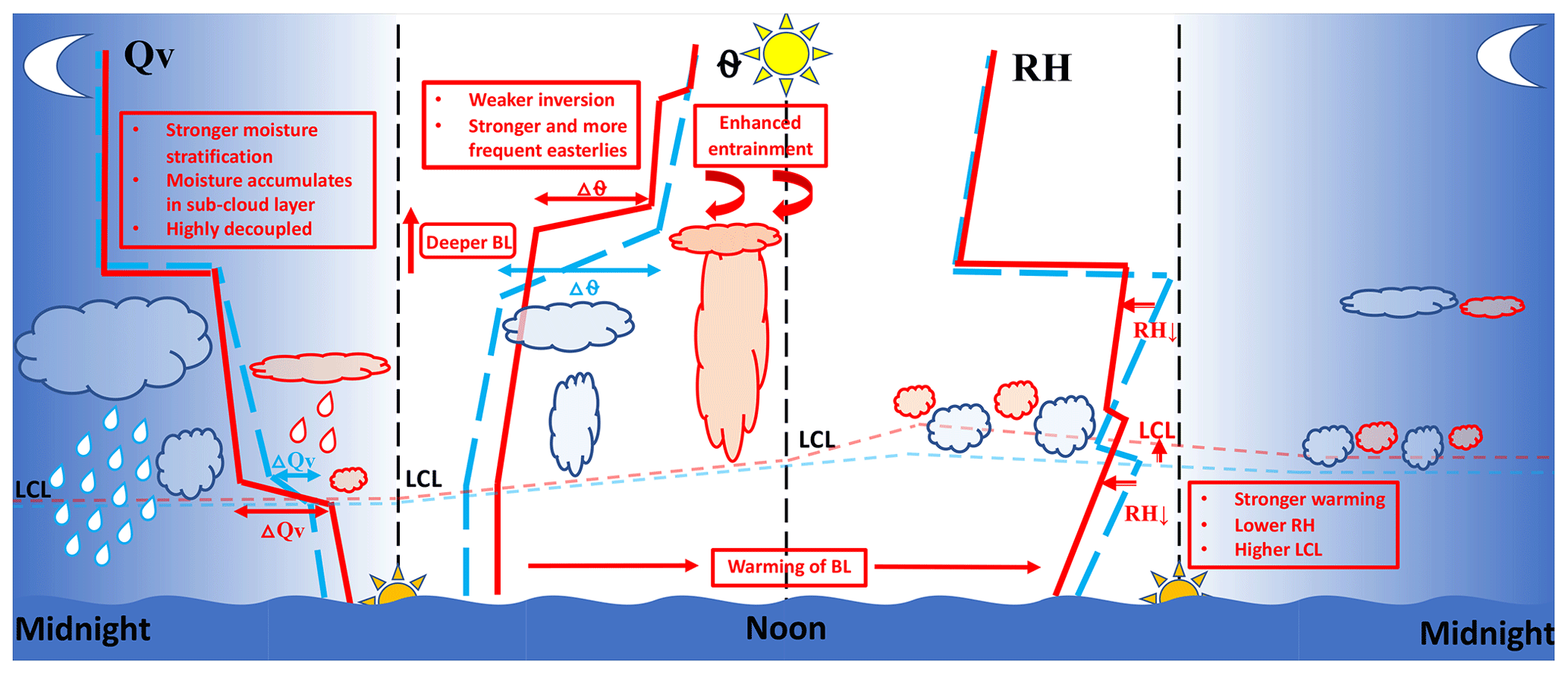The Impact of Biomass Burning Smoke on Clouds and Climate
Eastern subtropical oceans are home to warm and bright low-level stratocumulus cloud decks. Among them, the southeast Atlantic basin presents an unique opportunity to study smoke-cloud-radiation interactions where seasonally emitted biomass burning plumes from the southern African continent are being advected over the oceanic region via the southern African Easterly Jet. In this work, I investigated how the presence of biomass burning smoke affects marine boundary layer clouds, particularly in the remote southeast Atlantic region. I demonstrated that the presence of sunlight-absorbing aerosols in the boundary layer suppress cloud water and coverage by modifying the boundary layer’s thermodynamic structure and coupling state throughout the diurnal cycle.

The seasonal variation in the vertical distribution of smoke contributes to the amplification of the seasonal cycle in low-cloud fraction, with significant implications for regional climate dynamics and radiative effects.

These observationally based findings fill in the temporal dimension of aerosol `semi-direct’ effect and pose a challenging target for both process modeling and GCMs on their representation of aerosols, clouds, and their interactions with atmospheric circulations from diurnal to regional scales.
Related Publications
-
J. Zhang and P. Zuidema (2019): The diurnal cycle of the smoky marine boundary layer observed during August in the remote southeast Atlantic. Atmos. Chem. Phys., 19(23), 14493–14516. doi:10.5194/acp-19-14493-2019 (ACP highligh article)
-
J. Zhang and P. Zuidema (2021): Sunlight-absorbing aerosol amplifies the seasonal cycle in low-cloud fraction over the southeast Atlantic. Atmos. Chem. Phys., 21(14), 11179–11199. doi:10.5194/acp-21-11179-2021
-
P. Zuidema, A. Sedlacek III, C. Flynn, S. Springston et al. including J. Zhang (2018): The Ascension Island boundary layer in the remote southeast Atlantic is often smoky. Geophys. Res. Lett., 45(9), 4456–4465. doi:10.1002/2017GL076926
-
S. Abel, P. Barrett, P. Zuidema, J. Zhang et al. (2020): Open cells exhibit weaker entrainment of free-tropospheric biomass-burning aerosol into the south-east Atlantic boundary layer. Atmos. Chem. Phys., 20(7), 4059–4084. doi:10.5194/acp-20-4059-2020
-
P. Barrett, S. Abel, H. Coe, et al. including J. Zhang (2022): Intercomparison of airborne and surface-based measurements during the CLARIFY, ORACLES and LASIC field experiments. Atmos. Meas. Tech., 15(21), 6329–6371. doi:10.5194/amt-15-6329-2022
-
M. Diamond, P. Saide, P. Zuidema, et al. including J. Zhang (2022): Cloud adjustments from large-scale smoke–circulation interactions strongly modulate the southeastern Atlantic stratocumulus-to-cumulus transition. Atmos. Chem. Phys., 22(18), 12113–12151. doi:10.5194/acp-22-12113-2022 (ACP highligh article)
-
C. Howes, P. Saide, H. Coe, et al. including J. Zhang (2023): Biomass-burning smoke’s properties and its interactions with marine stratocumulus clouds in WRF-CAM5 and southeastern Atlantic field campaigns. Atmos. Chem. Phys., 23(21), 13911–13945. doi:10.5194/acp-23-13911-2023
Enjoy Reading This Article?
Here are some more articles you might like to read next: